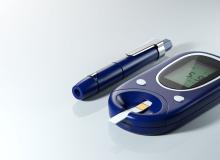According to surveys, 70% of diabetic patients cannot receive long-term and standardized treatment as required by their doctors. The following misunderstandings are relatively common and very harmful, and diabetics must avoid them.
Misunderstanding 1: Focus on fasting blood sugar and light on postprandial blood sugar
Fasting blood sugar can only represent blood sugar control during the night to before breakfast the next day. Increasing evidence suggests that postprandial hyperglycemia has an important impact on diabetes and its microvascular and macrovascular complications. Studies have shown that if diabetic patients only control fasting blood sugar but poorly control postprandial hyperglycemia, the incidence of myocardial infarction and mortality will increase.
Therefore, after being diagnosed with type 2 diabetes, not only do you need to check your fasting blood sugar frequently, but you should also take the trouble to monitor your postprandial blood sugar. We should not only focus on fasting blood sugar one-sidedly, nor should we one-sidedly think that fasting blood sugar is under control.
Misunderstanding 2: Focus on blood sugar and focus on glycated hemoglobin
Blood sugar test results reflect the immediate blood sugar level, which is a point concept, while glycated hemoglobin (HbA1C) can usually reflect the patient's blood sugar control in the past 2 to 3 months and is an indicator for evaluating long-term blood sugar. The closer the glycated hemoglobin level is to the normal value, the more significantly the risk of diabetes complications is reduced.
Therefore, real-time blood sugar needs to be measured, depending on your current blood sugar situation, and glycosylated hemoglobin should also be measured, because real-time blood sugar cannot reflect long-term blood sugar conditions, so both must be combined and measured.
Misunderstanding 3: Ignoring other necessary inspections
The long-term development of diabetes can produce severe macrovascular and microvascular complications, leading to functional abnormalities or even failure of various organs, especially the eyes, kidneys, nerves, heart and blood vessels. Therefore, in addition to paying attention to blood sugar, people with diabetes should also pay attention to other tests. For example, urine microalbumin should be checked every 3 months; fundus should be checked every six months; blood lipids should be checked every six months; blood pressure and electrocardiogram should be measured frequently.
Misunderstanding 4: Lack of nutritional knowledge
Nutritional therapy plays a crucial role in the treatment of diabetes. But many diabetic patients dare not eat anything except staple foods, vegetables and soy products. The energy obtained by these people with extreme partiality cannot meet the requirements of the body's basal metabolism and labor metabolism, resulting in malnutrition and serious consequences. Therefore, diabetic patients should have a balanced diet and never be partial to eclipses.
Misunderstanding 5: Neglecting exercise therapy
Quite a few patients don’t take exercise therapy seriously. As everyone knows, appropriate exercise can increase the sensitivity of body tissues to insulin, thereby lowering blood sugar; exercise can also enhance muscle strength, promote blood circulation, and delay the occurrence of small vessel disease.
Therefore, people with diabetes should engage in physical exercise unless they have active pulmonary tuberculosis, or have serious heart or kidney complications or ketoacidosis. Exercise projects should be done according to one's ability and should be carried out consistently.
Misunderstanding 6: Medication time and method are incorrect
Oral hypoglycemic drugs should be taken in conjunction with eating, such as before, during, and after meals. When applying insulin, attention should be paid to the injection site, injection method, and time.
1. All sulfonylureas can cause hypoglycemia and should be taken about 30 minutes before meals.
2. Biguanides should be taken with or after meals.
3. a-Glycosidase inhibitors mainly reduce postprandial blood sugar. They should be taken with food or without food. They should be taken orally immediately before a meal or with the first bite of a meal.
4. Insulin sensitizers need to be taken in the morning on an empty stomach.
5. Insulin secretagogues should be taken orally 5 to 20 minutes before meals and should not be taken without meals.
Misunderstanding 7: Eager to lower blood sugar and take a lot of medicine
When many patients are first diagnosed with diabetes, they wish they could lower their blood sugar in a day or two. In order to lower their blood sugar as quickly as possible, many patients often combine multiple drugs without authorization and take excessive doses.
Unreasonable use of large amounts of medication will not only fail to achieve the desired therapeutic effect, but will also aggravate the side effects of the medication. And blood sugar falling too fast is also very detrimental to diabetics. People with diabetes should develop a correct treatment plan under the guidance of a diabetes specialist, which should not only keep blood sugar under normal or close to normal range for a long time, but also avoid hypoglycemia or other serious events caused by blood sugar falling "too fast or too sharply". .
Myth 8: Fear of using insulin
At present, many diabetic patients have some misunderstandings about the use of insulin, and are even afraid of using insulin. Some people find insulin injections painful and inconvenient. Many diabetic patients believe that taking insulin means their condition is serious, and some are afraid that using insulin will lead to "addiction."
In fact, the benefits of insulin treatment for diabetic patients outweigh the risks. Insulin treatment can reduce fasting and postprandial hyperglycemia, improve insulin sensitivity of peripheral tissues, and improve lipid metabolism abnormalities, etc.
After using insulin in type 2 diabetes, you can still withdraw insulin again. Human pancreatic islets that have been stimulated by oral drugs for a long time can get a good rest after using external insulin. After the islet function has been restored for a period of time, some patients may continue to receive drug stimulation and exert the role of secreting insulin.
It is recommended that everyone learn more about diabetes to avoid misunderstandings, and also follow the doctor's advice. When it is time to use medicine, you should use it boldly and decisively.

